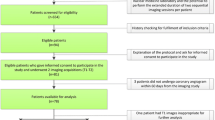Abstract
A second thallium-201 injection under resting conditions is able to improve the differentiation between myocardial scar and ischaemia when compared with simple redistribution imaging. The aim of this study was to evaluate the dependence of this improvement on the degree of stenosis and the presence of collaterals. Single photon emission tomography (SPET) studies under exercise, redistribution and reinjection conditions were performed on 84 patients with 181 stenotic vessels (70 left anterior descending, 47 left circumflex, 64 right coronary artery) and compared with angiography. An improvement of the 201Tl uptake in the reinjection image was observed in 53% of the myocardial areas served by a coronary artery with a stenosis of over 90%. This is compared with 13% of the areas served by a vessel with a stenosis between 50% and 90%. 90% of the collateralized areas showed a fill-in effect, but only 7 of the 118 without angiographically visible collateralization (6%). The dependence of the fill-in effect, collateralization and stenosis was highly significant (χ2 test, p < 0.0001). In our patient group, there was much greater benefit from the reinjection study in vessels with a > 90% narrowing. The fill-in effect was closely correlated to the presence of collaterals. In these cases, the fill-in may be an indication for hibernating myocardium.
Similar content being viewed by others
References
Bache RJ, Schwartz JS (1983) Myocardial blood flow during exercise after gradual coronary occlusion in the dog. Am J Physiol 245:131–138
Berger BC, Watson VD, Taylor GJ, Burwell LR, Martin RP, Beller GA (1980) Effect of coronary collateral circulation on regional myocardial perfusion assessed by quantitative thallium 201 scintigraphy. Am J Cardiol 46:365–370
Bonow RO, Dilsizian V, Cuocolo A, Bacharach SL (1991) Identification of viable myocardium in patients with chronic coronary artery disease and left ventricular dysfunction. Circulation 83:26–37
Braunwald E, Rutherford JD (1986) Reversible ischemic left ventricular dysfunction: evidence for the “hibernating myocardium”. J Am Coll Cardiol 8:1467–1470
Dilsizian V, Rocco TP, Freedman NMT, Leon MB, Bonow RO (1990) Enhanced detection of ischemic but viable myocardium by the reinjection of thallium after stress-redistribution imaging. N Engl J Med 323:141–146
Eng C, Patterson RE, Horowitz SF, Halgash DA, Pichard AD, Midwall J, Herman MV, Gorlin R (1982) Coronary collateral function during exercise. Circulation 66:309–316
Fuster V, Freye RL, Kennedy MA, Conolly DC, Mamkin HT (1979) The role of collateral circulation in the various coronary syndromes. Circulation 59:1137–1144
Goldberg HL, Goldstein J, Borer JS, Moses JW, Collins MB (1984) Functional importance of coronary collateral vessels. Am J Cardiol 53:694–699
Helfant RH, Kemp HG, Gorlin R (1970) Coronary atherosclerosis, coronary collaterals and their relation to cardiac function. Ann Intern Med 73:189–195
Kirsch CM, Doliwa R, Buell U, Roedler D (1983) Detection of severe coronary heart disease with Tl-201: comparison of resting single photon emission tomography with invasive arteriography. J Nucl Med 24:761–767
Levin DC (1974) Pathways and functional significance of coronary collateral circulation. Circulation 50:831–837
Marcus LM, Harrison DG (1991) Physiologic basis for myocardial perfusion imaging. In: Marcus ML, Skorton DJ, Schelbert HR, Wolf GL (ed) Cardiac imaging: a companion to Braunwald's heart disease. Saunders, Philadelphia, pp 8–23
Munz DL, Morguet AJ, Sandrock D, Toman AS, Figulla HR, Kreuzer H, Emrich D (1991) 201-Thallium-Re-Injektion nach Belastungs-Redistributionsmyokardszintigraphie. Dtsch Med Wochenschr 116:361–366
Nienaber CA, Spielmann RP, Salge D, Clausen A, Montz R, Bleifeld W (1987) Nichtinvasive Identifizierung von kollateralisiertem Myokard durch 201-Thallium-Tomographie in Vasodilatation und Redistribution. Z Kardiol 76:612–620
Picano E, Simonetti I, Masini M, Marzilli M, Lattanzi F, Distante A, DeNes M, L Abbate A (1986) Transient myocardial dysfunction during pharmacologic vasodilatation as an index of reduced coronary reserve: a coronary hemodynamic and echocardiographic study. J Am Coll Cardiol 8:84–90
Rahimtoola SH (1989) The hibernating myocardium. Am Heart J 117:211–219
Rentrop KP, Thornton JC, Feit F, Buskirk M van (1988) Determinants and protective potential of coronary arterial collaterals as assessed by an angioplasty model. Am J Cardiol 61:677–684
Sebree L, Bianco JA, Subramanian R, Wilson MA, Swanson D, Hegge J, Tschudy J, Pyzalski R (1991) Discordance between accumulation of C-14 deoxyglucose and Tl-201 in reperfused myocardium. J Mol Cell Cardiol 23:603–616
Schaper W, Schaper J, Xhonneux R, Vandesteene R (1969) Morphology of intercoronary anastomoses in chronic coronary artery occlusion. Cardivase Res 3:315–323
Schipke JD (1991) Down-Regulation and hibernierendes Myokard. Z Kardiol 80:703–711
Schober O, Hasfeld M, Matheja P, Schäfers M, Breithardt G (1991) Thallium reinjection vs redistribution in severe stenosis of coronary arteries dependent on the collateralization. Eur J Nucl Med 18:538
Schwarz F, Flameng W, Ensslen R, Sesto M, Thormann J (1978) Effect of coronary collaterals on left ventricular function at rest and during stress. Am Heart J 95:570–577
Tamaki N, Ohtani H, Yamashita K, Magata Y, Yonekura Y, Nohara R, Kambara H, Kawai C, Hirata K, Ban T, Konishi J (1991) Metabolic activity in the areas of new fill-in after thallium-201 reinjection: comparison with positron emission tomography using fluorine- l8-deoxyglucose. J Nucl Med 32:673–678
Author information
Authors and Affiliations
Additional information
Offprint requests to: P. Bartenstein
Rights and permissions
About this article
Cite this article
Bartenstein, P., Schober, O., Hasfeld, M. et al. Thallium-201 single photon emission tomography of myocardium: Additional information in reinjection studies is dependent on collateral circulation. Eur J Nucl Med 19, 790–795 (1992). https://doi.org/10.1007/BF00182821
Received:
Revised:
Issue Date:
DOI: https://doi.org/10.1007/BF00182821




